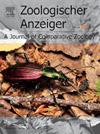Global diversity of mysids (Crustacea: Mysida) in lagoonal waters
IF 1.5
3区 生物学
Q2 ZOOLOGY
引用次数: 0
Abstract
A global compilation of mysid shrimp species found in coastal and atoll lagoons was conducted based on published records. The lagoonal species represent around 15 % (181 species) of the species in the Order Mysida and are found in 6 continents and one Micronesian region, excluding limans and Ponto-Caspian region. The species belong to one family (Mysidae), seven subfamilies (Erythropinae, Gastrosaccinae, Heteromysinae, Leptomysinae, Mysinae, Rhopalophthalminae and Siriellinae) and 16 tribes. The subfamily Mysinae Haworth, 1825 was the highest in species richness (66 spp.), while Heteromysinae Norman, 1892 was the lowest (5 spp.). The genus Siriella Dana, 1850 is predominant (30 spp.) among the 49 genera. The European continent has the highest species richness (39 spp.) in coastal lagoons and Micronesia, a region with no coastal lagoons, has the lowest (0). In contrast, Australia/New Zealand has the highest species (26 spp.) in atoll lagoon, while there are no records of atolls from European and South America continents. A significant strong correlation was found between number of surveyed lagoons and mysid species richness. Europe appears to have received the greatest research attention with respect to mysid species richness while South America and the Indo-West Pacific atolls have received the least. There is a clear separation of the species assemblages of lagoonal mysids among continents/region into two main clusters based on hierarchical cluster analysis, the first cluster is the North America with South America, and the second one is the other continents/region.
泻湖水域蛤壳类动物的全球多样性
根据已发表的记录,对沿海和环礁泻湖中发现的壳虾物种进行了全球汇编。泻湖物种约占Mysida目物种总数的15%(181种),分布于6大洲和一个密克罗尼西亚地区,不包括利曼斯和蓬托-里海地区。分属1科(蝇科),7亚科(红蝇科、天麻蝇科、异蝇蝇科、轻蝇蝇科、蝇蝇科、眼蝇科、小蝇科)16个族。物种丰富度最高的是Mysinae Haworth亚科(1825)(66种),最低的是Heteromysinae Norman亚科(1892)(5种)。在49个属中占优势的属(30种)在1850年。欧洲大陆沿海泻湖的物种丰富度最高(39种),没有沿海泻湖的密克罗尼西亚地区物种丰富度最低(0种)。相比之下,澳大利亚/新西兰的环礁泻湖中物种最多(26种),而欧洲和南美洲大陆的环礁则没有记录。调查的泻湖数量与菌类丰富度呈显著的强相关。欧洲似乎在mysid物种丰富度方面得到了最大的研究关注,而南美洲和印度-西太平洋环礁得到的关注最少。分层聚类分析结果表明,各大洲(地区)间泻湖蝇类的物种组合可明显划分为两大聚类,第一聚类为北美与南美,第二聚类为其他大洲(地区)。
本文章由计算机程序翻译,如有差异,请以英文原文为准。
求助全文
约1分钟内获得全文
求助全文
来源期刊

Zoologischer Anzeiger
生物-动物学
CiteScore
2.80
自引率
7.10%
发文量
75
审稿时长
>12 weeks
期刊介绍:
Zoologischer Anzeiger - A Journal of Comparative Zoology is devoted to comparative zoology with a special emphasis on morphology, systematics, biogeography, and evolutionary biology targeting all metazoans, both modern and extinct. We also consider taxonomic submissions addressing a broader systematic and/or evolutionary context. The overall aim of the journal is to contribute to our understanding of the organismic world from an evolutionary perspective.
The journal Zoologischer Anzeiger invites suggestions for special issues. Interested parties may contact one of the editors.
 求助内容:
求助内容: 应助结果提醒方式:
应助结果提醒方式:


